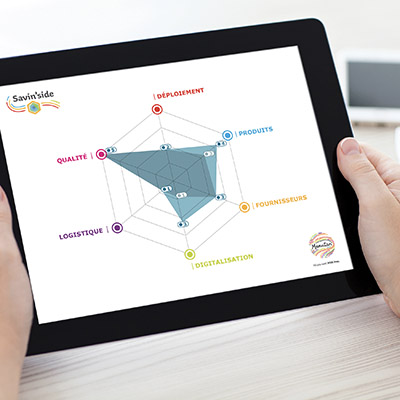To tackle the climate change and limit global warming, many companies from all sectors are committing to reduce their greenhouse gas emissions (often shortened as “GHG emissions”), even aiming to reach net zero emissions. As part of this approach based on emissions reduction targets, procurement departments have many levers to activate, particularly with their suppliers.
What does “net zero emissions” mean?
The net zero emissions principle involves minimising all greenhouse gas emissions produced by human activity as much as possible. In this configuration, any emissions that remain in the atmosphere are reabsorbed by carbon sinks, such as oceans and forests, for example. The final goal is to drastically reduce emissions to reach a balance between those produced and those offset.
The Paris Agreement set a key goal to fight the global temperature rise and climate change. This involves limiting global warming to well below 2° C (ideally 1.5 °C) compared to pre-industrial levels. As a result, many countries have committed to reducing global emissions by 55% by 2030, before reaching net zero emissions target by 2050.
This transition towards energy efficiency requires a complete transformation in how we produce, consume and travel. For companies committed to this approach, it is important to analyse how each link in the supply chain contributes to direct and indirect greenhouse gas emissions. This means identifying the sources and assessing their impact to target the areas where change is needed within the framework of a dedicated climate policy.
The importance of the three emissions scopes for a net zero emissions strategy
To join this international climate action movement, it is critical that companies strive to reduce their net greenhouse gas emissions, which are methodologically divided into three categories: scopes 1, 2 and 3.
Direct scope 1 emissions
Scope 1 covers direct greenhouse gas emissions from sources owned and/or controlled by the company. This refers to emissions from energy used for production (equipment and fixed and/or mobile installations), as well as vehicle fleets.
Indirect scope 2 emissions
Scope 2 includes indirect greenhouse gas emissions linked to energy. This covers electricity, heat, steam or cooling generation that is purchased and/or imported to support the company’s activities.
Indirect scope 3 emissions
Scope 3 refers to all other indirect greenhouse gas emissions. These emissions result from the company’s activities but originate from external sources. In fact, they relate to the entire upstream and downstream supply chain, from purchasing raw materials to waste management.
This type of emission generally represents between 80% to 90% of a company’s total emissions. Although this scope is particularly difficult to control, it remains essential for an effective net zero emissions strategy.
The role of procurement departments in achieving net zero
A credible and effective net zero emissions strategy must cover the entire value chain, with particular focus on the vast and complex scope 3.
Today, most companies have started to analyse and reduce their scope 1 and 2 emissions. Naturally, they have concentrated their efforts on the areas over which they have more direct control. However, scope 3 emissions account for the largest share. It is up to each company to use its influence within the value chain to deeply decarbonise the global economy.
Because it manages the company’s external resources, the procurement function plays a key role in reducing upstream scope 3 emissions with its suppliers. It is up to buyers to bring their partners on board, who are essential for the successful implementation of their company’s net zero emissions strategy. According to a report from the Science-Based Targets initiative (SBTi), a supplier is 68% more likely to commit to this approach if asked by two companies, and 76% more likely if asked by three companies. It is time to initiate the movement…
A net zero emissions procurement strategy
A net zero emissions procurement strategy relies on three key interdependent principles.
Integrating sustainability criteria into procurement processes
By integrating sustainability criteria into their procurement processes, companies encourage their suppliers to adopt more environmentally friendly practices and work towards carbon neutrality. For example, they can include clauses in their contracts that promote emissions reduction throughout the supply chain.
Measuring the environmental footprint of the supply chain
It is essential to measure the environmental footprint, particularly greenhouse gas emissions, of the products and services, both direct and indirect, purchased by companies. Reliable data on emission sources and volumes will enable them to effectively target their net zero emissions procurement strategy, monitor and assess progress in this area.
Fostering innovation and sustainable development
Companies should also encourage innovation among their suppliers who design the products and services of the future. Strategic partnerships focused on sustainability pave the way for innovative solutions that benefit the environment and businesses.
As you can see, implementing a net zero emissions procurement strategy is a prerequisite for ensuring a sustainable future and resilience to climate change. By reducing emissions at every level of the supply chain, companies can not only limit and lower their impact on the planet, but also stimulate innovation and strengthen their market position as responsible players.









